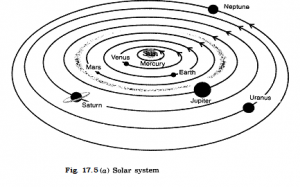NCERT TEXT BOOK EXERCISES
Q1. Which of the following is NOT a member of the solar system?
(a) An asteroid
(b) A satellite
(c) A constellation
(d) A comet
Ans. (c) A constellation.
Q2. Which of the following is NOT a planet of the sun?
(a) Sirius
(b) Mercury
(c) Saturn
(d) Earth
Ans. (a) Sirius.
Q3. Phases of the moon occur because:
(a) we can see only to that part of the moon which reflects light towards us,
(b) our distance from the moon keeps changing.
(c) the shadow of the Earth covers only a part of the moon’s surface.
(d) the thickness of the moon’s atmosphere is not constant.
Ans. (a) we can see only to that part of the moon which reflects light towards us.
Q4. Fill in the blanks:
(a) The planet which is the farthest from the Sun is …………. .
(b) The planet which appears reddish in colour is ………………. .
(c) A group of stars that appear to form a pattern in the sky is known as a ………..
(d) A celestial body that revolves around a planet is known as ………….. .
(e) Shooting stars are actually not ………….
(f) Asteroids are found between the orbits of ………. and ……….. .
Ans. (a) neptune
(b) mars
(c) constellation
(d) satellite
(e) meteor
(f)mars, Jupiter.
Q5. Mark the following statements as True (T) or False (F):
(a) Pole star is a member of the solar system.
(b) Mercury is the smallest planet of the solar system.
(c) Uranus is the farthest planet in the solar system.
(d) INSAT is an artificial satellite. There are nine planets in the solar system.
(e) There are nine planets in the solar system.
(f) Constellation Orion can be seen only with a telescope.
Ans. (a) False
(b) True
(c) False
(d) True
(e) False
(f) False.
Q6. Match items in column A with one or more items in column B.
|
A |
B |
| (i) Inner planets | (a) Saturn |
| (ii) Outer planets | (b) Pole Star |
| (iii) Constellation | (c) Great Bear |
| (iv) Satellite of the Earth | (d) Moon |
| (e) Earth | |
| (f) Orion | |
| (g) Mars |
Ans.
|
A |
B |
| (i) Inner planets | (g) Mars; |
| (ii) Outer planets | (e) Earth; |
| (iii) Constellation | (a) Saturn; |
| (iv) Satellite of the Earth | (c)Great Bear; |
| (f) Orion | |
| (d) Moon |
Q7. In which part of the sky can you see Venus if it is visible as an even star?
Ans. Western sky.
Q8. Name the largest planet of the solar system.
Ans. Jupiter (Brihaspati).
Q9. What is a constellation? Name any two constellations.
Ans. Constellations are a group of stars that appear to form some recognizable shape. For examples, Ursa Major and Orion.
Q10. Draw sketches to show the relative positions of prominent stars in:
(a) Ursa Major and (b) Orion.
Ans.
(a) 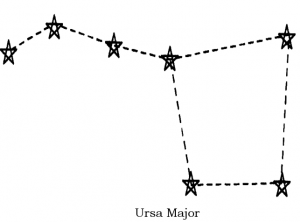
(b) 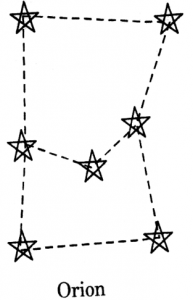
Q11. Name two objects other than planets which are members of the solar system.
Ans. Comets, asteroids and meteors.
Q12. Explain how you can locate the Pole Star with the help of Ursa Major.
Ans. Pole star can be located with the help of the two stars at the end of Ursa Major. Imagine a straight line passing through these stars as shown in Fig. 17.4. Extend this imaginary line towards the north direction. (About five times the distance between the two stars). This line will lead to a star which is not too bright.
This is the Pole Star. Pole star does not move at all as all other for the verification, the stars drift from east to west.
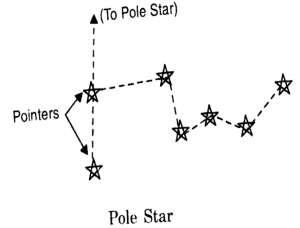
Q13. Do all the stars in the sky move? Explain.
Ans. No, stars actually do not move but they only appear to move from east to west, as the earth from where we see them, rotates from west to east. However pole star, which is situated in the direction of the earth’s axis. It does not appear to move.
Q14. Why is the distance between stars expressed in light years? What do you understand by the statement that a star is eight light years away from the Earth?
Ans. The Sun is nearly 150,000,000 kilometres (150 million km) away from the earth.
The next nearest star to the earth after the Sun is Alpha Centauri. It is at a distance of about 40,000,000,000,000 km from the earth. Some stars are even farther away. It is not convenient to express such distances in kilometres.
Such large distances are expressed in another unit known as light year. One light year is the distance travelled by light in one year.
If we say that a star is eight light years away from earth, it means that the light from that star will reach the earth in eight years.
Q15. The radius of Jupiter is 11 times the radius of the Earth. Calculate the ratio of the volumes of Jupiter and the Earth. How many Earths can Jupiter accommodate?
Ans. Student, do yourself.
Q16. Boojho made the following sketch (Fig. 17.5) of the solar system. Is the sketch correct? If not, correct it.
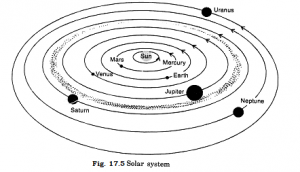
Ans. It is not correct. Figure 17.5 (a) is a correct sketch of solar system.
